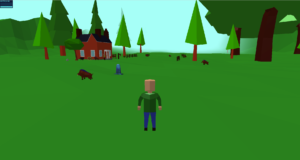I haven’t done a ton of testing with it yet but it looks like I have successfully implemented collision response a la Fauerby’s paper. I’ve only tried against a simple box but it is absolutely beautiful to watch a sphere collide with the box near the edge and just slide over until it’s past the edge then continue on its merry way. The code listings from the paper are, in my opinion, an absolute mess. I just don’t like code that follows this structure:
var object;
function doSomething(object) {
object.prop = “value”;
object.otherProp = “otherValue”;
}
doSomething(object);
if (object.prop == “value”) {
// whatever
}
I don’t like it when a function changes the properties of an object passed into it as a parameter, and Fauerby’s code does a bunch of that. Maybe that’s a very common practice for some programmers but it drives me crazy because it becomes very difficult to follow the values of an object’s properties. So I’ll be rewriting all that code but regardless of all that it seems to be working! So exciting. Once I’ve refactored this code I’ll integrate it into the rest of Lyridia’s code, then test some in the world and as long as everything looks good I’ll definitely release a new version at that point. So stay tuned.
